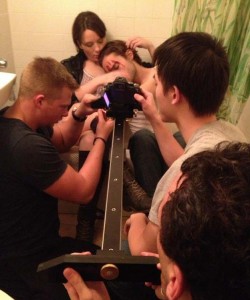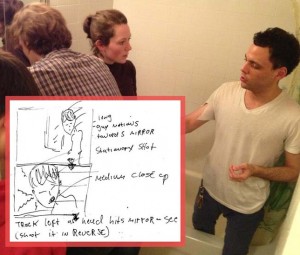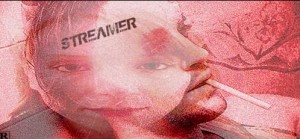
There’s nothing like a moody indie, horror film to start our gloomy Friday in L.A.
We screened, OK, streamed Streamer, a short film by Canadian filmmaker Jared Bratt, and we liked it.
Sitting on the edge of a tub in the bathroom, a young man motor mouths his thoughts and emotions, at a manic pace. Thoughts spew out about the object of his affection. In no time, the viewer recognizes the real she-devil qualities of the girl.
Played effectively by Ryan Leslie Fischer, and thankfully not venturing into the annoying as such thinking-out-loud dialogues do, staying with the film doesn’t become an obligation.

The red light treatment of the visuals along with the simplistic yet haunting theme music work hand-in-hand. Streamer is a low-budget indie, with big aspirations. It has potential as it showcases its young team of actors, and a film-team that put some thought behind this little project.
Streamer is crafty, mysterious, and entertaining. So, we decided to have a Q&A with its writer, director.
BNH: What is a Streamer?
JB: A Streamer is someone who doesn’t get out much — Out of their own head, that is. This person dwells too much, over-analyzes too many scenarios that they ultimately possess zero control over — He or she is basically frequently lost within the internal-oceans of his or her own dominating stream of consciousness.
BNH: What was the idea behind this short film?
JB: The idea was to make suspense and unease happen through performance, dialogue, lighting, editing, sound, and music. The concept came from a real enough place, and thus, I wanted to pull this suspense out of what becomes a relatable concept – relationship trouble. Not dating specifically, just the very idea of liking someone and hoping that they “like” you back, thinking they do, and then realizing that you simply misinterpreted their “signs”. There’s real suspense and “horror” in that, or in hoping to forget about that very memory and idea of that someone once you enter into the inevitable anger-stage — There’s suspense in that entire process. I wanted to take all of these ideas as fuel for (what I think is) an emotion-based, creative and surreal snippet of life-horror.
BNH: What were the 3 main creative decisions you stuck with? Explain
JB: #1. Focus on the acting. The performances will make or break a piece like this, and it was paramount that the actors feel comfortable. This also means even-though the script is dialogue-heavy, let the performers have total freedom to make the words their own and play with them. They should feel comfortable that they have choice (s). #2. To visually keep a story that is predominantly confined to a bathroom-setting appealing in the eyes of the audience. So I decided to break the bathroom-lighting up & keep the visuals changing (always making sense thematically) keep it exciting to literally look at (giving the film a visual-pace). As a result, color-scheme alters from a red-mask to regular-lighting, and then everything book-ends back to red just like how the film itself opens. #3. I wanted the short to start with someone getting stabbed. You literally don’t know why, and we just jump right into it. I wanted to rely on (again) the performances, lighting, sound, music, and editing to elicit the “horror” vibe from within the scene without letting the prop of blood do that (or shock) for us. We maintained this minimalist sensibility throughout, which also ultimately gave us more time to efficiently focus on the actors in the scenes.

BNH: And challenges?
JB: Everything was planned, from the call-sheets to the shots, and the order in which these shots would be carried out. We only had 2 real full-nights to shoot, and we knew exactly what was getting done and when. A challenge though was maybe opening up and allowing some room for that lightning on-the-spot creativity to channel. We did have to think on our toes in altering some of that pre-planned stuff so it could pave way towards a more practical way of shooting. We still kept the creative back-bone, but I guess, sometimes, when you want to be a stickler for time-constraints, not being too drastically rigid can be an unforeseen challenge.
BNH: You were shooting inside a real bathroom. Was that not difficult?
JB: Sure, but it made sense. My director of photography Vincent Pun, asked me: ‘Why in a bathroom?’ The more I justified it I realized if anything, it makes the most sense to be in a bathroom. You could say that’s the area of the house, an apartment, where we’re most vulnerable. Naked, literally and metaphorically! Now that I think about it, Vincent’s questions kept us in check. They made sure there was meaning behind what we were doing.
BNH: Is the final version the film you set out to make? How so and/or How did it change?
JB: I can honestly say that not only does the final-version of ‘Streamer’ match what I set-out to produce, but we surpassed even what I had set-up on the page from a script stand-point. Now this doesn’t mean nothing changed — One element that did (and for the better) was this stabbing scene that opens the film. On the page, it was conceived as a jarring moment played for shock-value. In naturally exploring the scene (not even in rehearsal) but a bit before the shooting of the sequence itself, I think we all naturally came to the conclusion that there is indeed this sexualized type of eroticism that ties into this violent act. So this bit changed into an action and sex scene of sorts, and that’s ultimately far more interesting I believe. It has to make sense, but if it can — Why not? We now had a much more layered, three-dimensional scene on our hands.
BNH: Three films that rocked your world, Go!
JB: From Dusk Till Dawn, Blue Velvet, Die Hard.
CLICK HERE to follow the film on Twitter.
CLICK HERE to see the trailer for STREAMER.


